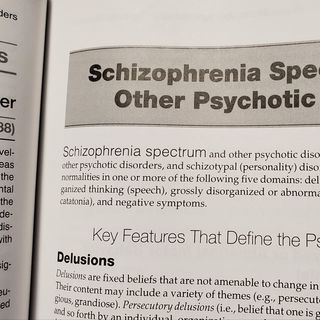Psychosis
Three Rare Psychotic Syndromes
Reviewing three of psychiatry's most unusual presentations.
Posted December 14, 2019 Reviewed by Kaja Perina

Psychosis has historically been defined as "the loss of contact with reality" and can be observed in various mental disorders, including schizophrenia, bipolar disorder, and major depressive disorder. The chief symptoms of psychosis include hallucinations, delusions, disorganized thinking, and a range of negative symptoms that represent an absence or loss of normal human experience.
Schizophrenia, long considered the classic psychotic disorder, demonstrates the complexity and heterogeneity of psychotic symptoms. Prior to DSM-5, the disorder was diagnosed according to five subtypes—paranoid, disorganized, catatonic, undifferentiated, and residual. More recently, some authors have suggested that "schizophrenia" is better understood as describing a range of different diseases, perhaps more than 100, rather than a single disease entity (Frances, 2013).
Since the founding of modern scientific psychiatry in the mid-to-late 1800s, a few rare clinical syndromes have been described in the literature that represent unique forms of psychotic illness. I will briefly present each syndrome here.
Cotard's Syndrome
Named after the French neurologist Jules Cotard (1840-1889), Cotard's syndrome is a type of illness in which the afflicted person holds the delusional belief that they are already dead, do not exist, are putrefying, or have lost their blood or internal organs (Berrios & Luque, 1995). Cotard originally used the term délire des negations to describe this phenomenon and believed it to be a distinct type of depressive illness rather than a form of delusion, a view that is supported by Berrios and Luque (1995).
I once saw a patient during my internship training who was identified by the attending inpatient psychiatrist as having Cotard's syndrome. A severely depressed elderly lady, she held the delusional belief that her heart and other organs had turned to stone. Like many patients with Cotard's syndrome, this patient went to an extreme length to attempt suicide: she had attempted to cut her head off with a chainsaw. We interpreted her delusional belief psychoanalytically as a concretization of an internal sense of "deadness," "lifelessness," and "coldness."
While Cotard's syndrome is not listed in DSM, "nihilistic delusions" are mentioned. The condition remains a poorly understood phenomenon, and, when encountered, is usually treated with antidepressant and antipsychotic medications, or electroconvulsive therapy.
Named for another French physician, the psychiatrist Joseph Capgras (1873-1950), Capgras syndrome is a condition in which a person holds the delusional belief that a friend, spouse, parent, or other close family member, has been replaced by an identical imposter. Most commonly observed in paranoid-type schizophrenia, Capgras syndrome also often presents in patients with neurodegenerative disease, such as Lewy body dementia, particularly at older age (Josephs, 2007).
Passer and Warnock (1991) describe a typical case:
Mrs. D, a 74-year-old married housewife, recently discharged from a local hospital after her first psychiatric admission, presented to our facility for a second opinion. At the time of her admission earlier in the year, she had received the diagnosis of atypical psychosis because of her belief that her husband had been replaced by another unrelated man. She refused to sleep with the impostor, locked her bedroom and door at night, asked her son for a gun, and finally fought with the police when attempts were made to hospitalise her. At times she believed her husband was her long deceased father. She easily recognised other family members and would misidentify her husband only.
Like Cotard's syndrome, Capgras syndrome is not listed in the DSM. It remains a poorly understood and understudied condition, and its treatment usually involves some combination of psychotherapy and antipsychotic medication.
Folie à Deux (Shared Psychotic Disorder)
Folie à deux, from the French for "madness of two," is a rare psychiatric syndrome in which delusional beliefs, and sometimes hallucinations (Dantendorfer, Maierhofer, & Musalek, 1997), are shared by two individuals in close proximity. An example of the condition would be a socially isolated couple wherein the husband initially develops a delusion that he is being targeted and monitored by the KGB, and the wife thereafter adopts this delusional belief herself. Folie à deux has also more recently been termed "shared psychotic disorder."
There is some evidence to suggest that social isolation is a main contributing factor to the development of a shared psychotic disorder. There is also some reason to believe that those with secondary cases, i.e., those who adopt the psychosis from the primary individual, may be more likely to have an underlying dependent personality disorder (Newman & Harbit, 2010).
While prior iterations of DSM have listed folie à deux as a distinct psychotic disorder, DSM-5 no longer separates delusional disorder from shared psychotic disorder. If criteria are met, then both afflicted individuals are diagnosed with delusional disorder.
Facebook/LinkedIn image: tommaso79/Shutterstock
References
Berrios, G. E., & Luque, R. (1995). Cotard's delusion or syndrome: A conceptual history. Comprehensive Psychiatry, 36(3), 218-223.
Dantendorfer, K., Maierhofer, D., & Musalek, M. (1997). Induced hallucinatory psychosis (folie à deux hallucinatoire): Pathogenesis and nosological position. Psychopathology, 30(6), 309-315.
Frances, A. (2013). Saving normal: An insider's revolt against out-of-control psychiatric diagnosis, DSM-5, big pharma, and the medicalization of ordinary life. New York: HarperCollins.
Josephs, K. A. (2007). Capgras syndrome and its relationship to neurodegenerative disease. Archives of Neurology, 64(12), 1762-1766.
Newman, W. J., & Harbit, M. A. (2010). Folie à deux and the courts. Journal of the American Academy of Psychiatry and the Law, 38(3), 369-375.
Passer, K. M., & Warnock, J. K. (1991). Pimozide in the treatment of Capgras syndrome: A case report. Psychosomatics, 32(4), 446-448.


